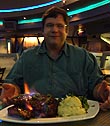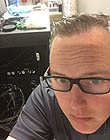|
|
This topic comprises 2 pages: 1 2
|
|
Author
|
Topic: Aperture Plate Question
|
|
|
|
|
|
|
|
|
John Walsh
Film God

Posts: 2490
From: Connecticut, USA, Earth, Milky Way
Registered: Oct 1999
|
 posted 09-15-2000 10:41 PM
posted 09-15-2000 10:41 PM




I'm sure that the openings in aperture plates shrink slightly over time, especially if they were filed with a "knife edge" which is usually the preferred method. The thin edge seems susceptible to heat cycles.About 6 months after a theater opens, I notice a slight shadow on the top of the screen because (I think) the projector has settled. With the weight (the projection head) in the front, it pulls the front down. And, (as others have noted) changing or adjusting the xenon bulb puts it in a slightly different position, whih can also cause a shadow. Masking motor limit switches and rigging shift a little, too. I always left about 1 foot around the masking (depending on the screen size.) Some people would think that's a bit too much, but I never had to go back and refile. Even with that, I was able to keep cropping equal to or less than 2%.
| IP: Logged
|
|
|
|
|
|
Neil Di Scala
Film Handler
Posts: 17
From: Santa Cruz, CA, USA
Registered: Sep 2000
|
 posted 09-16-2000 01:36 AM
posted 09-16-2000 01:36 AM




These are all excellent comments, reflecting experience uncommon in the industry. A couple of other factors include the condition of the bulb and reflector then and now (an older bulb and/or overheated reflector will throw a somewhat less focused beam, causing a bigger shadow).This entire topic of the optics is seriously under appreciated and a major flaw in the installation and maintenance in a lot of plexes. I have been doing some portable setups for animation and film festivals (lots of Spike & Mike) for a number of years, using 6 lamphouses with two projectors. The subtle changes in the optics mentioned above, with the repetition of sometimes once a week, make it apparent that a lot of new equipment installers don't really understand this part very well. I have seen a lot of new installation alignments that were close, but the benefits gained by centering the reflector on the arc and directly through the center of the aperture, through the center of the lens, and the center of the screen are substantial. In addition to the obvious benefits (more light at less amps) the depth of field of focus can be very different depending on the care of the installer. This is a very interesting subject, one in which there is a lot to learn.
| IP: Logged
|
|
|
|
|
|
Pat Moore
Master Film Handler

Posts: 363
Registered: Mar 2000
|
 posted 09-16-2000 07:50 AM
posted 09-16-2000 07:50 AM




Alan; since these are single lens projectors, good chance the apertures just aren't getting back to the exact same place each time you insert them. Are they tight when you slide them into the trap? Are they loose, and can you adjust shadows on screen by moving the aperture around in the trap?Could also be the lens holders and adapters as well. Most adapters have some play in them as they fit in the 4-inch holder and just don't quite register in exactly the same place each time. Clampng the lens in the holder a little more or less tightly can make a difference on screen, depending on the projector and the fit of the parts. I've found it's best, for instance, to give the lens a little "twist" in one direction as you tighten the holder, that usually gets things lined up in the same place. If the initial alignments of the system are setup the same that usually works fairly well. Don't forget that just the slightest change in alignment at the projector can make a significant change in the image location on screen. Depending on the throw and lens focal length, change in the projection angle of less than one degree can translate into several inches or more of change at the screen. Other suggestions above are good as well -- masking stops can drift, masking edges sag, etc. I think the more random things are probably projector-based, though, or there are real problems with the masking motors. I will say this: re-file apertures only after you know the problem lies there. Be sure to check film ratios and masking stops using RP40 test film before doing any filing. The aperture opening may require a little buffing now and again to get rid of burnt-on film and oil goo, but if the system was installed correctly by a good tech re-filing an aperture should be among the last things you need to do. Good luck!
| IP: Logged
|
|
|
|
|
|
|
|
|
|
|
|
All times are Central (GMT -6:00)
|
This topic comprises 2 pages: 1 2
|
Powered by Infopop Corporation
UBB.classicTM
6.3.1.2
The Film-Tech Forums are designed for various members related to the cinema industry to express their opinions, viewpoints and testimonials on various products, services and events based upon speculation, personal knowledge and factual information through use, therefore all views represented here allow no liability upon the publishers of this web site and the owners of said views assume no liability for any ill will resulting from these postings. The posts made here are for educational as well as entertainment purposes and as such anyone viewing this portion of the website must accept these views as statements of the author of that opinion
and agrees to release the authors from any and all liability.
|

 Home
Home
 Products
Products
 Store
Store
 Forum
Forum
 Warehouse
Warehouse
 Contact Us
Contact Us




 Printer-friendly view of this topic
Printer-friendly view of this topic











 stick with the plates and clean out the opening. Your problem is most likely there.
stick with the plates and clean out the opening. Your problem is most likely there.





